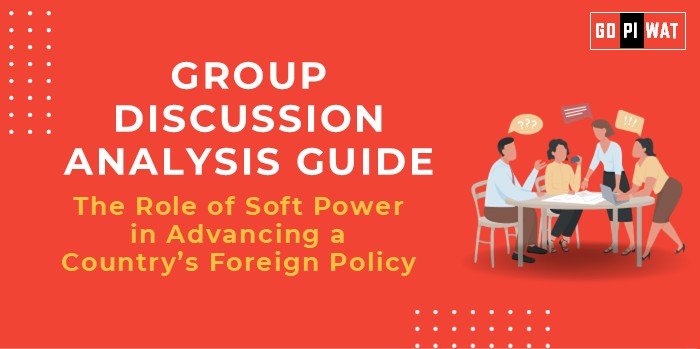📋 Group Discussion Analysis Guide: The Role of Soft Power in Advancing a Country’s Foreign Policy
🌐 Introduction to the Role of Soft Power
📖 Opening Context
In the interconnected world of the 21st century, power is not only about military might or economic clout but also about the ability to influence through culture, values, and diplomacy. Soft power is becoming increasingly vital for advancing a nation’s foreign policy.
📜 Topic Background
Coined by Joseph Nye in the 1990s, soft power refers to a nation’s ability to shape preferences and outcomes through attraction and persuasion rather than coercion. Countries like the United States, Japan, and South Korea have used soft power to strengthen global influence through cultural exports, technological leadership, and strategic alliances.
📊 Quick Facts and Key Statistics
- 🎥 Cultural Exports: The U.S. earns $64 billion annually from Hollywood, influencing global perceptions.
- 📚 Education Diplomacy: 1.1 million international students studied in the U.S. in 2022, strengthening ties with future global leaders.
- 📻 Media Outreach: The BBC World Service reaches 492 million weekly, showcasing the UK’s soft power reach.
- 🌍 Global Rankings: Germany ranked 1st in the 2023 Soft Power Index, reflecting its cultural and economic influence.
🤝 Stakeholders and Their Roles
- 🏛️ Governments: Use cultural diplomacy and foreign aid to enhance influence.
- 🏢 Corporations: Promote national brands and innovation as symbols of soft power (e.g., Apple for the U.S.).
- 📚 Educational Institutions: Attract international students and foster global academic exchanges.
- 📰 Media Outlets: Shape perceptions through global news coverage and entertainment exports.
- 🌐 International Organizations: Enhance credibility through participation in UN, WHO, etc.
🏆 Achievements and Challenges
✨ Achievements
- 🎵 Cultural Impact: K-pop and Korean dramas have significantly boosted South Korea’s global standing.
- 🎓 Education: Scholarships like Chevening and Fulbright cultivate pro-nation sentiments among future leaders.
- 💻 Technology Diplomacy: China’s Belt and Road Initiative includes digital infrastructure projects to influence recipient countries.
⚠️ Challenges
- 🔍 Perception Management: Misinformation campaigns can undermine soft power efforts.
- 🛡️ Cultural Resistance: Globalization faces pushback in regions where cultural preservation is prioritized.
- 💰 Economic Constraints: Developing nations may lack resources to invest in soft power initiatives.
🌍 Global Comparisons
- ✅ China: While Confucius Institutes promote cultural diplomacy, controversies about political influence have arisen.
- ⚖️ Nordic Countries: Strong emphasis on gender equality and human rights boosts their international image.
📖 Case Studies
- 🧘♀️ India’s “International Yoga Day” Initiative: Demonstrates soft power via cultural heritage.
- 📘 Germany’s Goethe Institutes: A model for promoting cultural and language programs globally.
💡 Structured Arguments for Discussion
- 🛠️ Supporting Stance: “Soft power fosters long-term relationships and positive perceptions, creating a conducive environment for policy negotiations.”
- 🛡️ Opposing Stance: “Soft power lacks the immediacy of hard power and may falter in the face of geopolitical conflicts.”
- ⚖️ Balanced Perspective: “While not a replacement for hard power, soft power complements traditional diplomacy by shaping global narratives.”
🎯 Effective Discussion Approaches
🔑 Opening Approaches
- 🎬 “With over 1 billion followers of Bollywood globally, India’s cultural diplomacy exemplifies the power of soft influence.”
- 📺 “As digital platforms redefine media consumption, nations are leveraging streaming services to bolster their soft power.”
⚙️ Counter-Argument Handling
- 🔄 Acknowledge: “Soft power cannot solve immediate conflicts, but it remains indispensable for fostering mutual understanding and trust.”
🧠 Strategic Analysis of Strengths and Weaknesses
SWOT Analysis:
- 💪 Strengths: Cultural richness (India, France); global media dominance (U.S.).
- 🛠️ Weaknesses: Susceptibility to political shifts; unequal access to resources.
- 🌟 Opportunities: Expanding digital diplomacy; collaborative initiatives like climate action.
- ⚠️ Threats: Nationalistic backlash; geopolitical tensions disrupting cultural exchanges.
🏫 Connecting with B-School Applications
📚 Real-World Applications
- 🌍 Projects exploring the intersection of marketing and national branding.
- 📊 Research on international trade influenced by cultural diplomacy.
🎓 Sample Interview Questions
- ❓ “How can soft power complement economic policies in foreign relations?”
- ❓ “Evaluate the role of soft power in building sustainable alliances.”
💡 Insights for B-School Students
- 📈 Understanding soft power strategies aids in cross-cultural negotiations.
- 🤝 Developing leadership styles inspired by soft power diplomacy.


